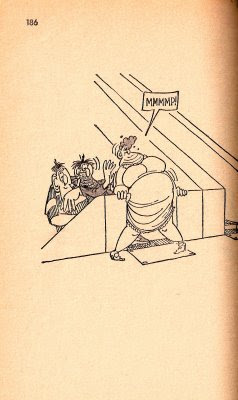Handicap Bouldering (grades)

Okay, this is all a bit of fun, and grade-obsession in climbing only disillusions me, but a comment on the ever-entertaining Sam's World of Pain popped out at me, and being older and heavier than most boulderers these days, I thought I'd develop my own grading system! According to Sam, via Steve McLure, half a stone (7lbs or 3.2kg) is equivalent to half a grade (a 'plus' or 'minus' grade eg. 8a to 8a+). This got me thinking, is there not a handicap system out there, like there is for horse-racing? In my world of new grades, skinnies should be climbing with weight-belts and fatties get a numerical headstart!
1. Work out how many half stone you are above or below average weight.
The 'average man' principle:
The average man is allocated 110 lbs (50 kg) for the first 5 feet (1.524 m) in height. Thereafter, he is allocated 5½ lbs (2.495 kg) for every additional inch (0.025 m) in height.
Thus, a man 6 feet tall (1.829 m) would be allocated 110 lbs (50 kg) plus 12 x 5½ lbs (2.495 kg), which comes to 176 lbs or 12 st. 8 lbs (80 kg).
Females are allocated 100 lbs (45 kg) for the first 5 feet (1.524 m) and 5lbs (2.268 kg) for every inch thereafter. Therefore a woman who is 5 ft 6 ins (1.676 m) tall would be given 100 lbs plus 6 x 5 lbs, which totals 130 lbs or 9 st. 4 lbs (59 kg).
2. Subtract or add one half grade for each half stone above or below average weight. Half stone = 7 lbs = 3.2kg
3. Whatever grade you last achieved, add or subtract the plus or minus handicap for your 'real grade'
I climbed a 7a last week so via the new handicap grade system, where I am rather astonishingly 2 stone 'overweight' (it's still post-Christmas, okay?), I 'really' climbed 4 half grades harder, therefore I maxed out at 7c... for January that's a big yeehah! If you are 2 stone 'underweight' and did the same problem you maxed at Font 6b... weakling, eat some creatine!
Therefore, to achieve 8a, that magical bouldering grade where you suddenly turn into some levitating guru (or a boastful arse), you can be average weight and do it, or you can be 3 stone overweight and climb a 7a. If you are a stone 'underweight', you'll have to climb an 8b to get the 8a!
This will no doubt displease and demotivate you hard-campussing skinnies and delight the genetically-challenged heavyweights...but hey, welcome to reality according to Stone Country!!!


